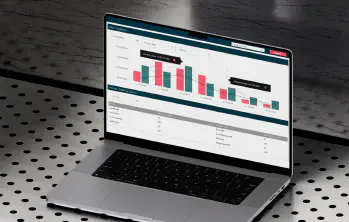Cross-product manipulation in financial markets
When it comes to regulatory enforcement, one of the most complex market manipulation typologies is cross-product manipulation (as well as cross-market manipulation) This involves manipulating one asset class to impact the price or perception of another related asset class. While it’s different from single-instrument manipulation, it’s also important to differentiate it from arbitrage, which is perfectly legal.
A simple example of cross-product manipulation would be traders trading in the derivatives market to influence the underlying asset’s value. The increasing interconnectivity of global financial markets and the wide variety of tradable products have opened up many opportunities for rogue traders. Historic regulations made little mention of cross-product manipulation, so they need to be updated. Then there is the issue of cross-market/cross-country cooperation.
While technological advances have increased the efficiency and liquidity of many markets, they also provide a range of different opportunities for those looking at more complex manipulation.
Scope and relevance across asset classes
The mention of cross-product manipulation will draw many eyes towards derivatives, but this problem goes much deeper. It can involve a whole range of different assets, including:
- Equities
- Bonds
- Interest rates
- Forex
- Commodities
When you consider the effect of, for example, equity manipulation on the value of indices and the knock-on effect of futures markets and index trackers, for instance., the full impact of the issue starts to become more evident. Recently, we have seen the LIBOR scandal, in which traders were able to impact interest rates and, as a consequence, a vast range of financial products based upon this one figure.
It is not difficult to see how this can significantly impact market efficiency and investor trust.
Technology and interconnectivity
Advanced trading technologies, such as algorithmic and high-frequency trading have not only presented the perfect tools to those looking to manipulate markets but can also exacerbate the impact. In milliseconds, manipulative trading in one market or asset can have a ripple effect worldwide, with data processing and trading happening in real-time.
In theory, with cutting-edge regulatory technology available, ensuring compliance with marketing trading regulations and replicating knowledge in one market to others would seem relatively simple. The reality is much more complex. It’s not only the ability to interconnect markets, regulators, and different products but also the ability to create systems that can create a connected timeline of events that prove market manipulation.
The introduction of AI and machine learning languages and complex algorithms creates an element of “on-the-job” learning, but the perpetrators are constantly innovating.
Distinguishing cross-product from cross-market manipulation
The subject of cross-market manipulation will likely arise when discussing cross-product manipulation. It’s important to appreciate the distinct differences between these two types of manipulation:
Cross-market manipulation
In essence, this is manipulating the same instrument across multiple markets or trading venues. Not to be confused with arbitrage, which is perfectly legal and based upon naturally occurring price differentiation, there is clear intent to manipulate prices.
Cross-product manipulation
Distinct from cross-market manipulation, cross-product manipulation involves trading one asset to influence a related but distinct asset. Aside from the more obvious derivative scenario, this type of trading could include purchasing a particular commodity, such as gold, to push the price higher and impact the perceived value of a gold mining company.
Wider consequences
If we look at the impact of derivatives in relation to equities, on a broader outlook, this can also impact investor/market sentiment. The effect can be far-reaching if traders notice movement in a particular equity or derivative on the back of critical data points (support and resistance levels).
When a change in one of the assets prompts a new trend, a huge volume of data is needed to create connection points. Thankfully, new AI services can analyse vast data sets and cross-check to find connections and timelines between different products.
Regulatory landscape and challenges
The challenge for regulators is simple: building on ever more complex regulations to identify and specify instances of, in this case, cross-product manipulation. The topic is covered in a range of US regulations such as:
- US Securities and Exchange Act 1934
- 1933 Securities Act
- 1936 Commodity Exchange Act
- Title 18 of the US code
It’s also important to consider the role of organisations and exchanges such as FINRA and the CME and how they address market manipulation rules for their members.
In the EU and the UK, there are specific references to cross-product market abuse in regulations, including:
- EU - Market Abuse Regulations (MAR)
- UK - MAR 1.6 Market abuse (manipulating transactions)
The US, EU and the UK are the regulatory leaders in financial markets. One often overlooked issue with a more interconnected global market is the need for individual countries to follow this broad global regulatory structure to attract and maintain foreign investment.
Risk exposure and implications for firms
The regulations covering cross-product manipulation are centred on market efficiency and trust. Financial institutions need to introduce and update appropriate surveillance for many reasons.
Fines
When it comes to cross-product manipulation, the majority of fines have involved what is known as spoofing. Spoofing involves placing false orders (the trader has no intention of fulfilling them) to manipulate an order book and give a different outlook to a specific asset. There have been numerous multi-million dollar fines involved in interest rates, derivatives, and commodities.
Reputational damage
Reputational damage can be more harmful than a multi-million dollar fine in many ways. Historically, your reputation may have opened doors and prompted lucrative partnerships, but this can change overnight. Media outlets can often prolong the agony with emotive headlines and a constant flow of accusations.
Loss of investor confidence
The relationship between a financial institution and clients can take decades to nurture, but due to reputational damage, it can disappear in an instant. If proven to be involved in regulatory breaches, this would place doubt into the minds of investors who may indirectly have been financially impacted.
Rogue traders
Rogue traders can inflict extensive damage on both institutions and markets. Even if proven to have acted in isolation, at best, this can highlight gaps in surveillance and compliance. As we mentioned above, the knock-on effect can be significant regarding fines, brand damage, and increased compliance spending.
Detection and surveillance challenges
While cross-product manipulation is not necessarily a new strategy, the introduction of cutting-edge technology has facilitated more complex and approaches which are harder to detect. It’s important to remember that this is not an easy challenge. It is a constantly moving target, and due to the vast, multi-market data required for analysis, it is technologically and financially demanding.
Traditional surveillance tools are unlikely to capture these sophisticated patterns in market manipulation. Consequently, financial institutions are now looking to outsource their compliance and regulatory obligations. This has seen a considerable increase in the Regtech sector and investment in compliance surveillance systems.
Case study
While there are many instances of cross-product manipulation, the LIBOR scandal may be the most alarming and potentially most damaging regarding reputation and financials. In 2012, several major global banking institutions were found to have manipulated LIBOR. This allowed the banks to influence borrowing costs and trading profits, directly influencing the value of often complex derivatives.
The reputational damage to money markets reverberated worldwide as the LIBOR was used to value everyday financial products such as mortgages. An example of irretrievable reputational damage, LIBOR was eventually replaced in June 2023 after a prolonged period of untangling its influence across the financial world.
How was the LIBOR scandal uncovered?
In a perfect example of a disconnected regulatory compliance sector, it was only by chance that a secret recording of bankers discussing market/product manipulation emerged. Fast-forward to the current day, using unstructured and structured data to monitor background conversations and interactions would likely have uncovered the scandal relatively early.
Best practices for combating cross-product manipulation
As cross-product manipulation becomes more complex, there is a renewed focus on technology. Recognising the opportunities presented by new, cutting-edge technologies is essential, but there are also other supportive issues to consider.
Robust policies and governance
Ignorance is not an excuse, so financial firms must maintain up-to-date internal policies that clearly define manipulative practices and outline the consequences.
Training and Education
While training and education will focus more on traders and investment advisers, it should be extended to all employees. Discussing manipulation, ethics, and the potential consequences for individuals, clients, and the company ensures employees know what to look for.
Data integration
As mentioned above, one of the earliest challenges with cross-product manipulation was integrating data sources. Creating an appropriate timeline using trade orders, communications, and relevant external data is critical to identifying abuse and supporting enforcement.
Outsourcing compliance monitoring obligations allows financial institutions to focus on their core services, utilising cutting-edge third-party technology, incorporating flexibility and a forward-thinking approach to regulations.
Innovative solutions in the market
As a leading supplier of Regtech services, eflow provides a range of flexible solutions to an ever-changing regulatory landscape. The ability to draw together data from numerous sources, analyse vast amounts of information, and identify instances of potential cross-product manipulation is critical in the fight to maintain market integrity and the reputation of financial institutions.
Using structured and unstructured data, we can help identify possible red flags for further investigation and provide critical supporting information. The ability to integrate our surveillance tools, incorporating the latest cutting-edge technology, into existing systems is a vital element of our evolution.
Using predictive analytics, sophisticated AI models, and complex algorithms allows us to identify suspicious activity. However, new challenges constantly emerge as criminals become more refined and innovative. So, rest assured we are continually looking to expand and improve our services, taking in new threats and strategies to help fulfil your regulatory obligations.
Conclusion: Preparing for the future
While cross-product manipulation is an emerging topic in compliance and regulation, it is not a new activity. We can identify common patterns, raise red flags, and assist with investigations only because of the emergence of cutting-edge technology, AI, and complex algorithms.
The ability to analyse massive data reams, identify patterns, and create timelines has undoubtedly changed the regulatory landscape. But this is not a one-off activity; it is an ongoing process with a degree of proactivity but mostly reactivity, adapting to new threats.
All types of market manipulation have the potential to erode trust and reputation, the foundations of financial markets. If you are concerned about your regulatory obligations going forward, please contact us, and we can discuss your options in detail.



